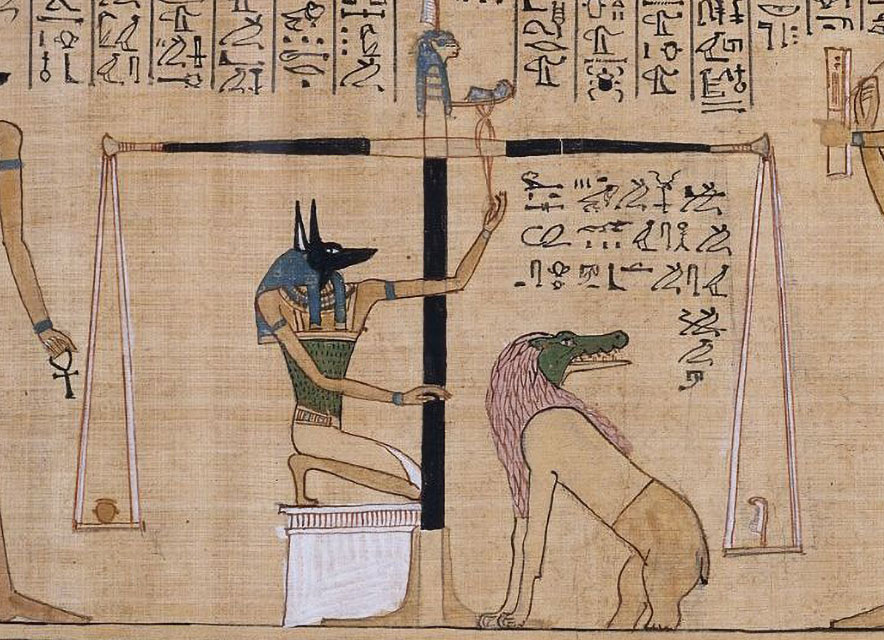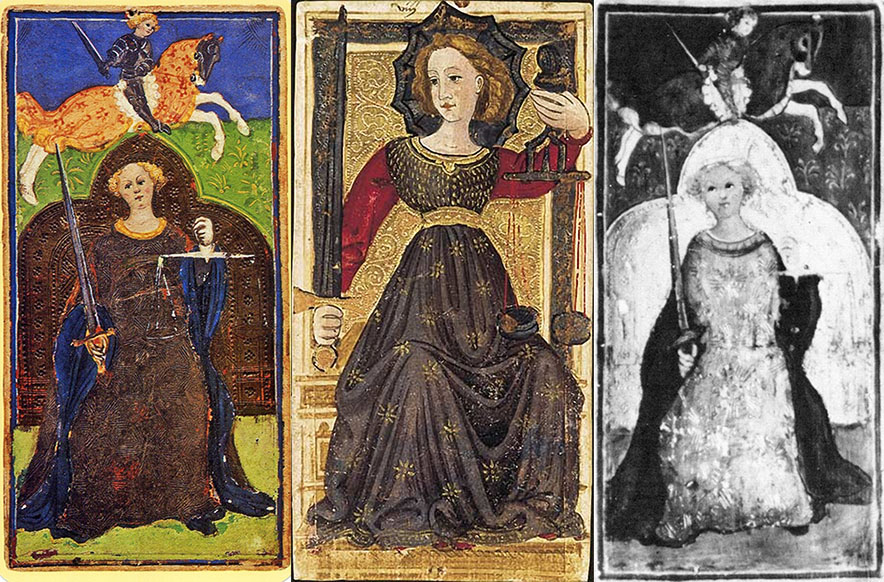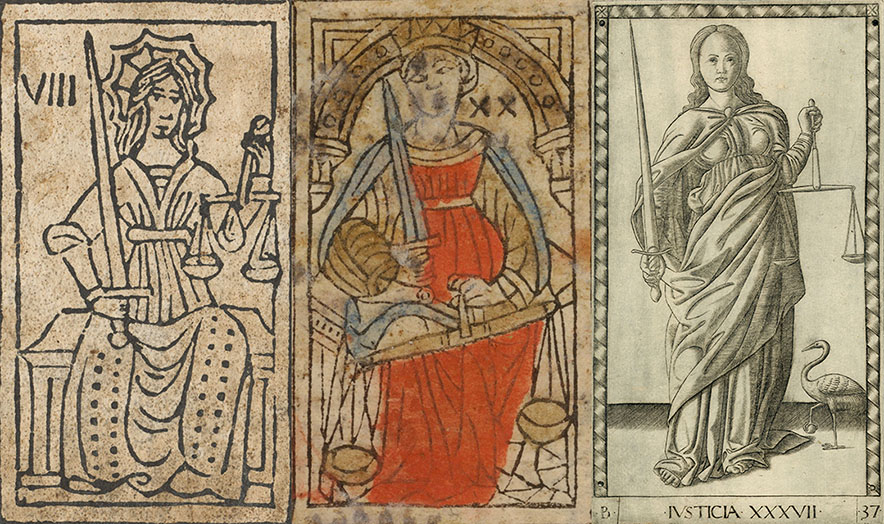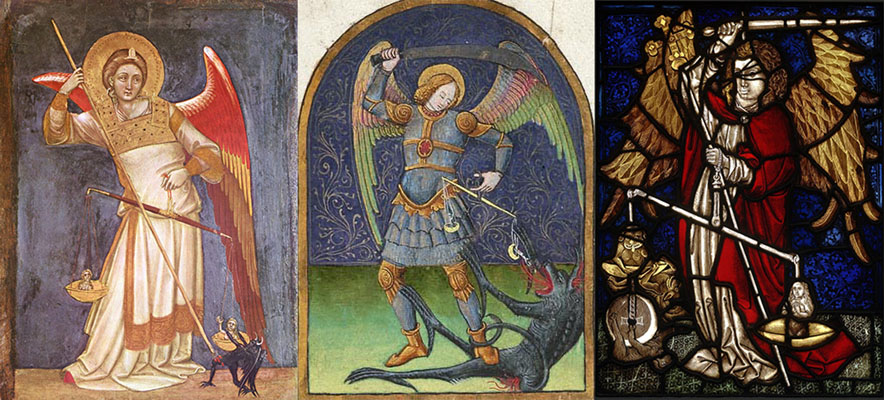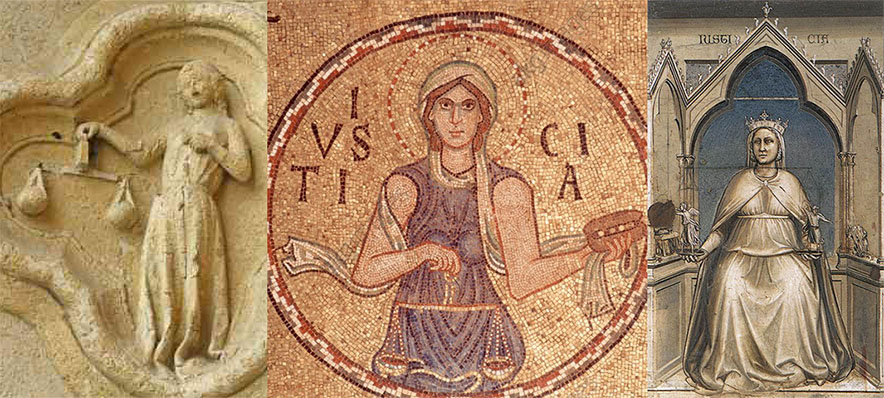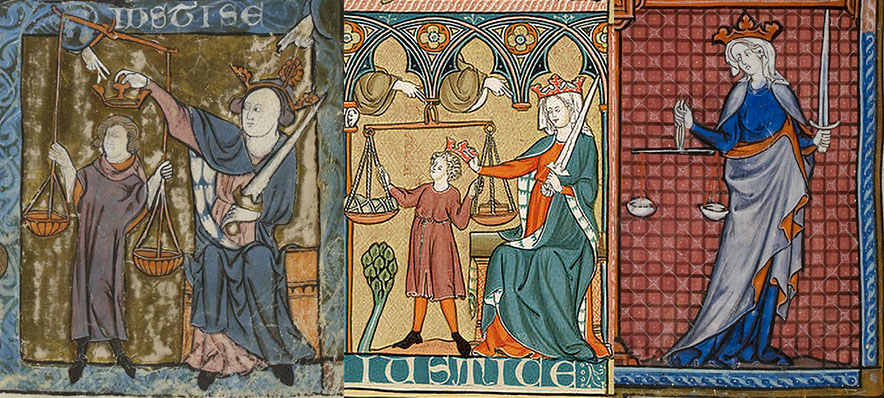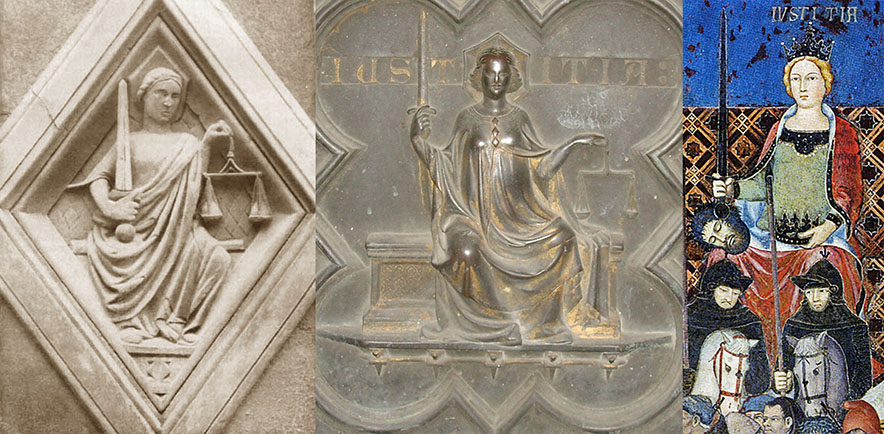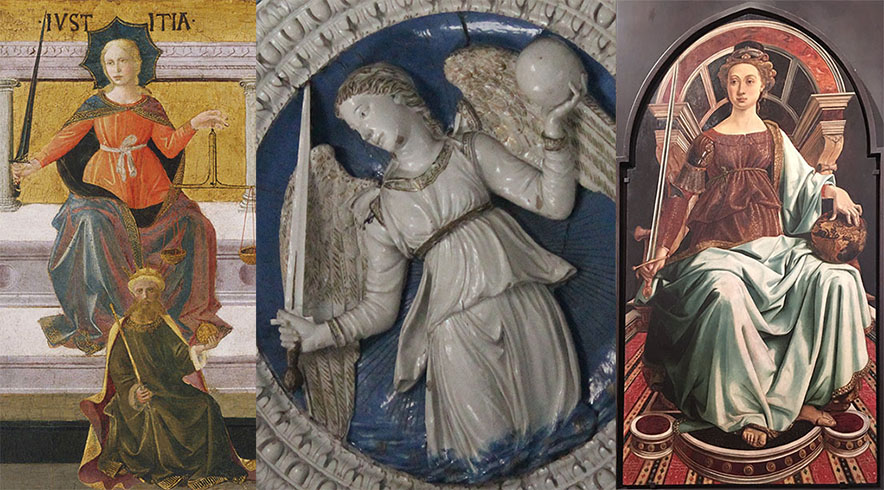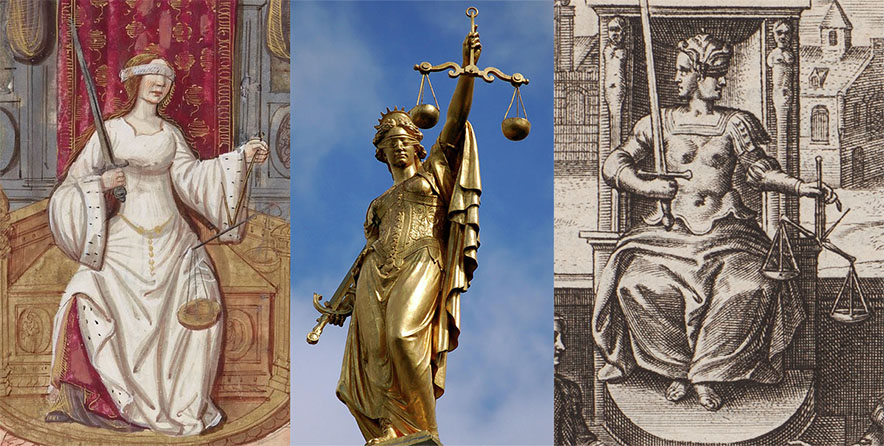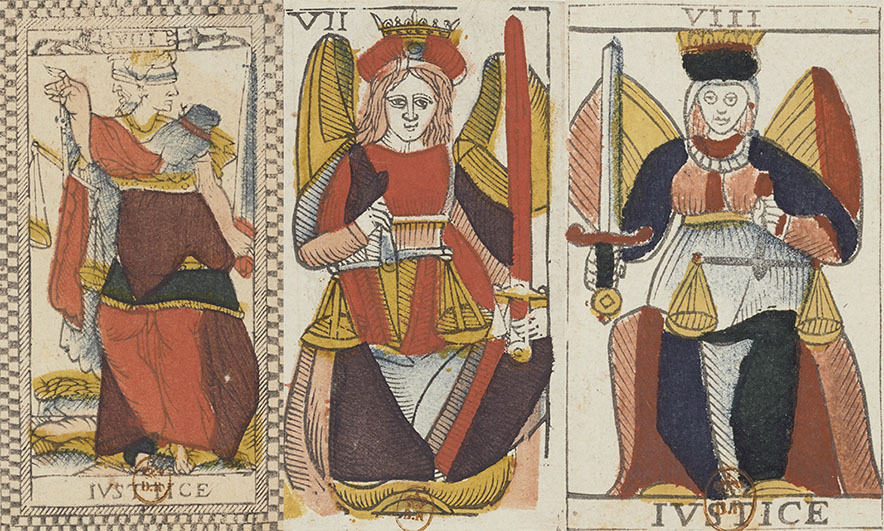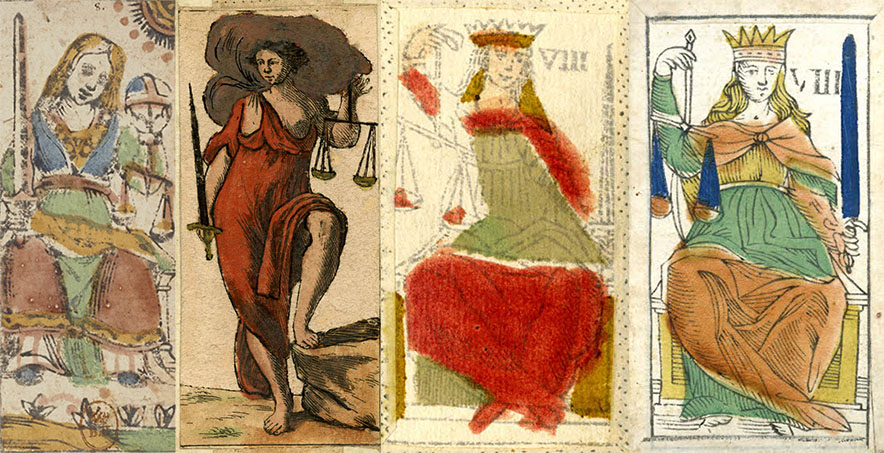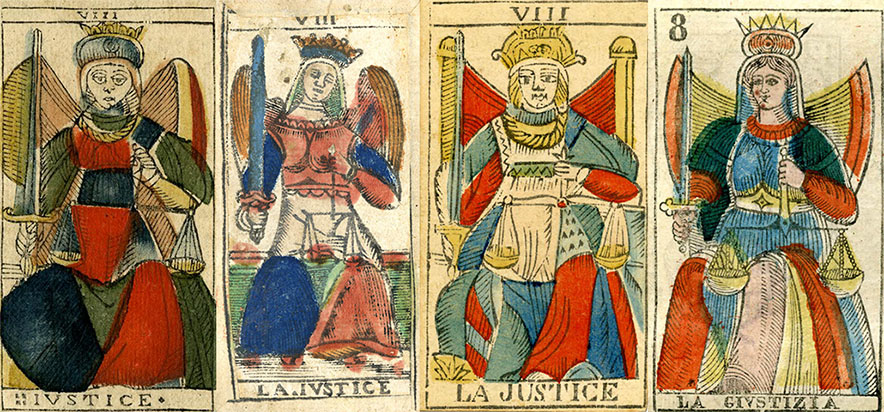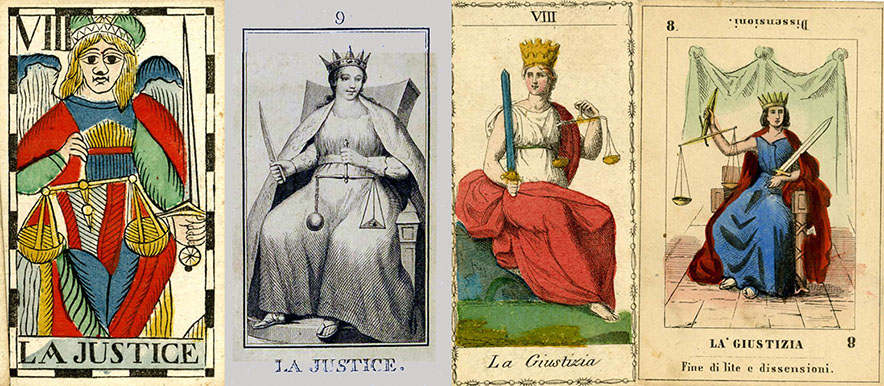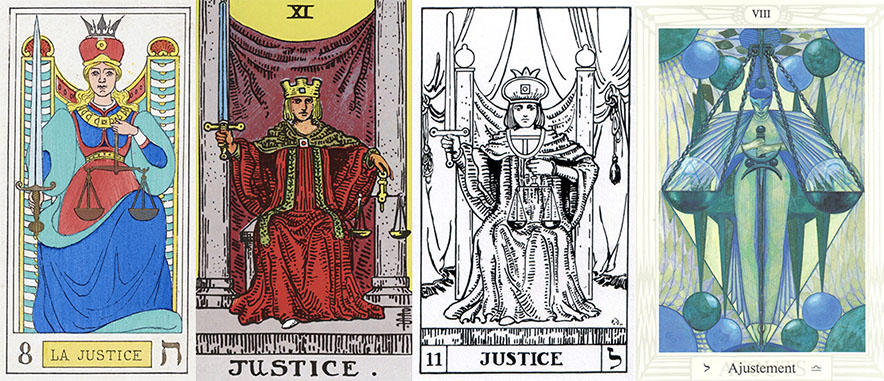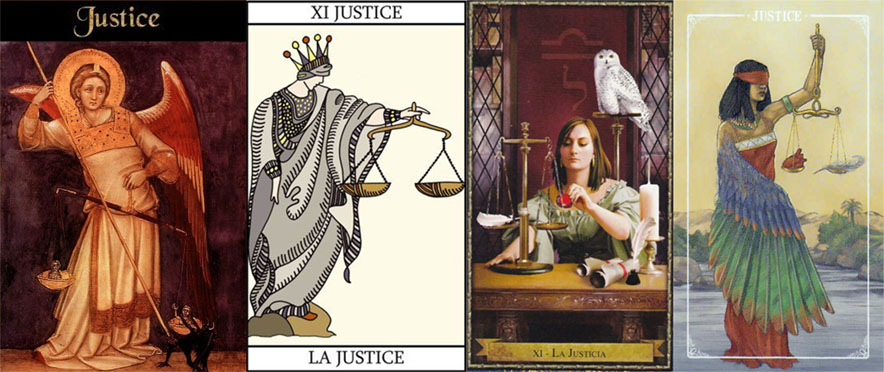THE TAROT WHEEL
LA JUSTICIA - JUSTICE
The concept of justice is as old as humanity. Its symbolism has been fixed thousands of years ago. Here above we have a detail of an illustration on the Egyptian papyrus of Hunefer, that contains a copy of the Egyptian book of the dead, dating to approximately 1375 BC. On this illustration, the heart of a deceased person is balanced against the feather of truth, also called the feather of Maat. Maat is the Egyptian goddess of truth and justice. In classic Greece, the Egyptian culture was well known and studied, and so also here the balance was a symbol of justice. In classic Greece, justice was ruled by a goddess, called Themis, who was in fact the Goddess of wisdom and council. The daughter of Themis was called Dike, and she was the real goddess of Justice. The main attribute of Dike was a balance with two scales. In classic Rome, the goddess of justice, the equivalent of Dike, was called Justitia (or Iustitia), and she was at the origin of the later representations of Justice. Les us see, how the virtue of Justice was portrayed on the 15th Century Trionfi cards.
Four hand-painted cards survived time. From left to right we have the Milanese virtue of Justice of the Visconti Sforza deck, dated to 1452-1454, the Ferrarese virtue of Justice of the Charles VI deck, dated to 1460-1475 and a card very similar to the Visconti Sforza card belonging to the so called Bononi collection. This card is believed to be a copy of the Visconti Sforza card, realized in the second half of the 15th Century. The image here above is from Stuart Kaplan's Tarot Encyclopedia, part 2. There is no color image known of this card, and the actual location of the card is also not known. There exists a fourth card, of which the last known location was in the Milanese Rosenthal collection. This card is also very similar to the Visconti Sforza card. I do not dispose of a reasonable image of this card, and even the actual location can not be mentioned with certainty.
On the Visconti Sforza card and its two copies, we see the virtue of Justice sitting with a sword in her, right hand, and a balance in her left one. There is no scabbard visible. Above her, a knight on a horse with a drawn sword, ready to execute the decisions of Justice. The Charles VI card has a very similar virtue of Justice, with the same attributes in the same hands. On this card, there is no knight present. The virtue of Justice is wearing a headdress in the form of a spiderweb, a symbol common to all the virtues.
The question is now, what is the Sword of Justice doing on a card representing the virtue of Justice? A virtue is a characteristic in the behavior of someone. According to Plato, Justice was the greatest of all virtues, and could be assimilated with wisdom. So the virtue of Justice is representing someone's ability to make the right decisions in a situation of conflict. A sword, in the context of justice, is a symbol of authority and of the judicial power. The Sword of Justice is an attribute of Lady Justice, the personification of the judicial system. Before trying to understand this representation of the virtue of Justice, let us have a look at how Justice was depicted on printed 15th Century Tarot cards.
Here above two cards that were part of a bigger uncut sheet and one print. The uncut sheets have been found back in the bindings of old books and can be dated to the end of the 15th Century. The first card on the left is from the so-called Rosenwald sheet. Two copies exist, one conserved in the National Gallery of Arts in Washington and one in the Spielkarten Museum in Leinfelden Germany. The sheet now conserved in Washington, was rejected because it was printed in mirror. The Leinfelden copy is in a very bad shape, so the image here above is a mirrored copy of the Washington sheet. The second copy is from one of the so-called Budapest sheets. The Budapest Museum of Art has five partial sheets with trump cards, and the Metropolitan Museum in New York has another one. The copy here above is from the sheet conserved in the Metropolitan Museum. The third image is not from a Tarot deck, it is from a series of 50 prints previously attributed to Mantegna. We know these prints under the name of the Tarot of Mantegna. The virtue of Justice is numbered 37.
Talking about numbers, we remark that the virtue of Justice is numbered VIII (8) on the Rosenwald card and XX (20) on the Budapest card. The reason is that the Rosenwald card is numbered according to the Bologese tradition, with the three virtues grouped together as the numbers 7, 8 and 9. The Budapest sheets are numbered according to the Ferrarese tradition, where the virtue of Justice is placed between the card representing the Angel (Judgement) and the World. The virtue of Justice has here the same spiderweb headdress as on the Charles VI deck, that has been attributed as ordered by the court of Ferrara. If we ignore the details that are less important, both the Rosenwald card and the Budapest card are identical to the Charles VI card. The virtue of Justice on the Mantegna print is not sitting, but standing. Otherwise, she is identical to the representation on the other cards. Behind the virtue of Justice is standing a Heron, a bird that symbolizes longevity, serenity and patience. The Heron is often associated with spirituality and wisdom, and is thus the perfect companion of the virtue of Justice.
We remark that the virtue of Justice is identical on all 15th Century cards, with a sword in the right hand and a balance in the left one. So this does not answer our question of what the Sword of Justice is doing on a card representing the virtue of Justice. Let us have a look at the art in the Middle Ages and the Renaissance to see how the representation of the virtue of Justice developed over time.
In the Ferrarese tradition, in placing the virtue of Justice in between the Rise for Judgement (the Angel) and Eternity (the World), the scales of the virtue of Justice became, like on the Egyptian image here above, associated with the weighing of the human heart, the base of God's decision to let a soul enter in Paradise or to have him sent to Hell. This interpretation of Justice is expressed in the images here above, where the archangel Michael is weighing a human soul, while struggling against a devil who wants to take the soul to hell. From left to right, we have a painting realized around 1350 by Guariento di Arpo, probably in Venice, an illustration from a 1470 Milanese Book of Hours, and a stained-glass window, realized around 1470 in Nuremberg, maybe originating from the local St. Lorenz church. We remark that on two of the three images, the archangel Michael is fighting against the devil with a sword and on the other with a spear. However, the archangel Michael does not represent the virtue of Justice, and his sword is not the Sword of Justice. It is, like the spear, a weapon used to fight against the devil, who is trying to steal some human souls. Let us have a further look at how the virtue of Justice was depicted in Medieval and Renaissance art.
The virtue of Justice first appeared in the beginning of the 13th century, and then only in religious art works. In the beginning, this was a perfect representation of the virtue of Justice, with an illustration of a woman holding a balance in her right hand, traditionally the strongest and thus the most important hand. From left to right, we see here first a bas-relief from the cathedral of Amiens in France, dated to the very beginning of the 13th Century. The second image is a 13th Century mosaic from the San Marco cathedral in Venice, and the last image is a fresco painted by Giotto di Bondone in the Scrovegni chapel in Padua. On the two first images, that are in a typical Medieval style, the virtue of Justice has a balance as her main attribute. The balance symbolizes the wise and measured decisions of Justice, taking all arguments into account. On the fresco made by Giotto di Bondone, one of the first Renaissance artists, the virtue of Justice is also holding a balance. She is holding the two scales in her hands, to express that the virtue of Justice is a wise woman, being able to judge by herself, based on her long experience. Inside the scales, two little figures represent clemency and punishment. For Giotto, the virtue of Justice is, like for Plato, clearly the most important virtue. She has the central place among the virtues, and her painting is bigger than those of the other six represented virtues.
In 1279, the Dominican friar Laurent, confessor of King Philippe III, and tutor of his children, wrote on the request of the king, a moral treatise about the virtues and vices. This treatise, that can be considered as a moral and religious instruction manual, was intended to educate the children of the king to the moral values of life. The manuscript was very appreciated, and it became some sort of Medieval bestseller, with several hundreds copies made in the next two hundred years. The three images here above are all from early copies, made at the end of the 13th Century. The first image is a copy realized in 1294 by the clerk Perinz de Falons, only 15 years after the original manuscript was made. The second image has been painted around 1300 by an unknown artist. The third image has been realized in 1295 by a clerk called Maître de Papeleu for King Philippe IV. On the first two images, we see the virtue of Justice as a queen with a sword in her left hand putting a crown on the head of one of her children, who she is educating in the moral values of Justice. From the heavens, two hands are blessing the queen and her son. On the third image we have just the virtue of Justice, also depicted as a queen, with a balance in her right hand and a sword in her left one. The sword is a symbol for authority, to indicate that the decisions of Justice are final, and that its decisions will be promptly executed.
The sword on these images appeared, maybe because the manuscript served to educate royal children, who once could become King themselves. In the Middle Ages, secular Justice was a privilege of the King, who could delegate this privilege to lower ranking nobleman in specific geographic areas. Their role was not only to decide in matters of justice, but also to have their decisions executed. This fact allows us to understand better the presence of the Sword of Justice on the Justice cards of the hand painted Trionfi decks, that were made on the order of Italian Dukes, responsible for justice in their Duchy. As a matter of fact, these Trionfi cards were also made with the purpose of educating the children on the ducal courts.
In 14th Century Italy, the sword had become a standard attribute of the virtue of Justice. In fact, all pieces of art executed in the Middle Ages and the Renaissance, were ordered by members of the ruling class, responsible for justice on their territory. The first image is from the Campanile of the cathedral in Florence, designed by Giotto di Bondone, who conducted from 1334 to 1337 the construction of the cathedral. This particular relief was made in 1334 by the workshop of Andrea Pisano. The next image was made by Andrea Pisano himself, in 1338, one year after the death of Giotto. From the death of Giotto until his own death in 1348, caused by the outbreak of the Black Death, it was Pisano who was appointed to oversee the construction of the cathedral. The bas-relief is part of a bronze door of the baptistery next to and part of the cathedral complex. On both images we see the virtue of Justice sitting with a sword in her right hand and a balance in her left one, very similar to the images we have seen on the 15th Century Trionfi cards. We remark on both images that the virtue has a hexagonal headdress, that reminds us of the headdress in the form of a spiderweb, that we have seen on the Charles VI and Rosenwald cards. The third image is a detail of the Allegory of Good Government, a fresco painted in 1338 by Ambrogio Lorenzetti in Siena, in the council hall of the Republic of Siena's nine executive magistrates, who were in charge of Justice in secular matters. Here, the virtue of Justice, again with a crown on her head, another symbol of authority, has a sword in her right hand and a crown in the left one. Under her right hand, a decapitated head, from someone executed on the decision of Justice. So on this fresco, the accent shifted from the decision-making part of Justice to the execution of the decisions. On this representation of justice, the original values of the virtue of Justice are hard to find.
Also in the 15th Century, most representations of the virtue of Justice use the attributes of the balance and the sword to depict this virtue. The first image on the left is a typical example, created around 1450 by the Florentine painter Francesco di Stefano, better known as Il Pesselino. In this image we see a very traditional virtue of Justice with a sword in her right hand and a balance in the left one. Her headdress has the form of a spiderweb, indicating that she represents a virtue. Below her feet the opposite vice of Injustice. However, other symbolism for the virtue of Justice was still possible. The second image is from the ceiling of the Chapel of the Cardinal of Portugal in the Basilica di San Miniato al Monte in Florence. This piece of art was realized in 1461 by the Florentine painter Luca della Robbia. In this image, the virtue of Justice is presented as an angel holding a sword in her right hand and a globe in her left one. In effect, in the Middle Ages and Renaissance, Justice was seen by the Christians as a representation on Earth of God in Heaven. The globe in the hands of the virtue represented the wish for a domination of Justice on Earth. The third image presents the virtue of Justice in the same way, with a sword in the right hand and a globe under her left one. This painting was realized in 1471 by the Florentine painter Piero di Pollaiuolo, younger brother of the more famous Antonio di Pollaiuolo, who helped him probably to finish the painting.
In the 16th Century, we see another change in the representation of Justice, with a new attribute, the blindfold. This attribute symbolizes the impartiality of Justice; nobleman, cleric or peasant, for Justice there should be no difference. From left to right, we have an illustration taken from a French manuscript, realized in the first half of the 16th Century, consisting of a collection of prose and verses concerning historical kings and mythological heroes. The second image is a sculpture that can be found on the roof of the ancient civil registry in Bruges (Belgium), realized between 1534 and 1537. The third image is a detail from a print realized in 1567 on the request of Joost de Damhoudere, a Flemish jurist. Here we see a double-headed Justice. The side facing the balance is blindfolded to emphasize the impartiality of the decisions of Justice. The side facing the sword, however, is not blindfolded, to emphasize that the decisions of Justice will be executed with precision down to the last detail.
The balance, the sword and the blindfold became the attributes of Lady Justice, the personification of the judicial system, actually used by the judicial authorities all over the world. However, in the same way as the virtue of Justice cannot be confounded with the archangel Michael, weighing the human souls, the virtue of Justice can also not be confused with Lady Justice, the personification of the judicial system. The real virtue of Justice represents wisdom, the capability of someone to make the right decisions, and not a judicial system.
With all the information gathered from Medieval and Renaissance art, about the development of the representation of the virtue of Justice, and how this representation became mixed with that of Lady Justice, by adding the Sword of Justice, lets us see how this virtue was represented on the Tarot cards, in the 17th Century and onwards. Let us begin with the three French 17th Century Tarot cards we have, all three of them realized in Paris.
From left to right, we have the anonymous Tarot of Paris, realized somewhere in the first half of the 17th Century, the Tarot of Jaques Vievil, realized around 1645 and the Tarot of Jean Noblet, realized around 1659. On all three cards we see the balance and the sword. On both the Tarot of Paris and the Tarot of Vievil, Justice has the balance in her right hand and the sword in her left hand, exactly as on the Medieval French manuscripts. On the Tarot of Noblet this has been switched, corresponding now to the 15th Century Trionfi cards. The Justice of the Tarot of Paris is double-headed and blindfolded on both sides, on the other two cards she has no blindfold and is looking straight at us, as if she wants to pierce our soul. Looking at these images, it seems that the anonymous card maker of the Tarot of Paris did not very well understand the symbolism of both the virtue of Justice and Lady Justice. It also looks as if both the virtues of Justice on the Vievil and Noblet cards are trying to manipulate one of the scales of the balance, with both knee and elbow, as if they want to influence the decisions of Justice. Remark also that on the Tarot of Paris and the Tarot of Noblet, the word Justice has no article. The reason is that we see on the cards a personification of the virtue of Justice, that excludes as such an article.
In Italy, the game of Tarot had disappeared in the 16th Century in most of the country. It only survives in regional formats in Bologna and to a lesser degree in Florence. In Bologna the Tarocchino game, a Tarot game where 16 pip cards had been removed, was invented at the end of the 15th Century, and it is played in Bologna and its surroundings until today. In Florence appeared in the 17th Century the Minchiate with 41 instead of 22 trump cards. Here above, from left to right, an anonymous standard Tarocchino card dated to the very beginning of the 17th Century, a non-standard Tarocchino card created around 1665-1668 by Giuseppe Maria Mitelli, an early Florentine Minchiate card and an 18th Century Minchiate card created in Bologna. The standard Tarocchino card uses several symbols for the virtue of Justice. In her right hand she has a sword and in her left hand she has both a balance and a globe. Mitelli created his Tarocchino deck by order of the wealthy Bentivoglio family, former rulers over Bologna. On his card, we see the virtue of Justice standing with a sword in her right hand and a balance in the left one. She has a naked breast, that is often seen as a symbol for freedom. Translated to the Justice card, it could be a symbol for the independence of Justice. The next two Minchiate cards are very similar. Here the virtue of Justice has the balance in her right hand and the sword in the left one. Remark that she has her ankles crossed, that that is frequently interpreted as a symbol for hiding something.
Here above, we see four TdM style Justice cards. From left to right, we see first Justice from the Tarot of Jean Dodal, produced in Lyon in the first years of the 18th Century. Next to her, we have a Justice card from the Tarocco of Francesco Berti, dated to the end of the 17th Century and produced in Bologna. The third card is from a Besançon style deck published in the 18th Century by Joseph Krebs in Fribourg en Brisgau, a town in Germany, close to the French border. The last card is from a Piedmont style deck published by Vergnano in the early 19th Century in Turin. On all decks we see an illustration very similar to the card of Jean Noblet with three differences. On the two Italian cards, the virtue of Justice does not look straight in our eyes and on all cards made outside France, Justice gets an article. Third difference, on the Italian cards there seems to be no attempt to manipulate the balance.
By the end of the 18th, and in the beginning of the 19th Century, some different Tarot decks emerge. From left to right, we start with a Belgian Tarot, created in 1775 by François-Jean Vandenborre in Brussels. The second image is from a Tarot deck created in 1783 in Paris by the occultist Jean-Baptiste Alliette, better known as Etteilla. We remark that even this occultist keeps the sword, symbol of the authority of the judicial system, in his representation of the virtue of Justice. The third card is from the Lombardy Tarot, a deck printed in 1810 by Gumppenberg in Milan. The last card is from an anonymous early 19th Century Tarocchi deck, specially made for fortune-telling. The images on this deck are in general based on the Etteilla deck, but the numbering follows the TdM tradition. On all four cards here above, the virtue of Justice has a balance and a sword as attributes. However, the balance of Etteilla is non-traditional, with on one side a metal ball and on the other side a scale in the form of a triangle. Also, her sword looks more like a kitchen knife than like a real sword. Only on the Belgian Tarot, the virtue of Justice is looking us straight into our eyes.
The Tarot of Etteilla opened a whole series of occultist Tarots. From left to right, we first have the 1889 Justice card from the Swiss occultist Oswald Wirth, who was based in Paris in France. Next to this card, the 1909 Justice card, created by Pamela Colman Smith under the guidance of Arthur Edward Waite. The third card is from the B.O.T.A. Tarot, published in 1947 by Paul Foster Case, founder of the Builders of the Adytum. The last card is created in 1944 by Frida Harris under the guidance of Aleister Crowley and published for the first time in 1969. All four cards show the virtue of Justice with a balance and a sword as main attributes. We remark that the different occultists did not agree about the number of the card, nor about the correspondence between the Tarot cards and the Hebrew alphabet. In fact, Comte de Mellet in Court de Gebelin's book "Le Monde Primitif" was the first to discuss this correspondence, but it was Eliphas Levi who assigned, according to a meaningful system, each Tarot card to a specific letter of the Hebrew alphabet. Oswald Wirth was using this system, and the letter Chet is here assigned to the Justice card. Waite changed the number of Justice from 8 to 11 and changed also the assignment to each number, so Justice became associated to the letter Lamed. Aleister Crowley considered this change in number as an error, so he put the cards back in the TdM order. Despite this, he conserved the association of Waite, so Justice stayed associated with the letter Lamed. Remark that the Etteilla decks are never displayed with a Hebrew letter associated to the cards. However, the essential for us is, in light of our discussion about the iconography of the Justice card, that both French and British/American occultists conserved the attributes present on the TdM Justice card.
Most modern cards still use the attributes of Justice of the TdM decks, the balance and the sword, adding sometimes the blindfold. In the last series of cards, that were all published in the 21st Century, I have chosen to show only cards that present Justice as the original virtue, so without the Sword of Justice. The blindfold is tolerated, because it reinforces the idea of an honest weighing of all arguments in a conflict. From left to right, we first have the original digital version of the Golden Tarot, published by Kat Black in 2004. For her deck she used different art works, painted between 1300 and 1500 in the International Gothic style. On the card of Justice, we see a copy of a masterpiece representing the archangel Michael weighing a human soul, painted by Guariento di Arpo, presented already earlier on this page. The second card is a very stylized version of a blindfolded virtue of Justice, coming from the Tarot Lover's Tarot, created in 2013 by Karyn Easton. The third card is from the Wizard's Tarot, published in 2011 by Corrine Kenner and John J. Blumen. On this card, we see the virtue of Justice in the process of weighing a human heart against the feather of Truth of the Egyptian goddess Maat. Behind her, on the wall, the symbols for the Zodiac sign Libra and the Hebrew letter Lamed. She is accompanied by an owl, that is nowadays the ultimo symbol of wisdom. The last card is from the Ostara Tarot, created in 2017 by Molly Applejohn, Eden Cooke, Krista Gibbard and Julia Iredale. Here we see a blindfolded virtue of Justice, who is, like on the preceding card, weighing a human heart against the feather of Truth. She has the balance in her left hand, while her right arm has the form of the wing of an owl.
With these four cards, we arrive at the end of our journey through time in the company of the Justice card. We have learned that the virtue of Justice has as main attribute a balance. We have also seen that on most pieces of art, all ordered by the noble class of society, the sword, the attribute of Lady Justice as personification of the judicial system, has been added as an attribute to the virtue of Justice. The main reason was probably that these same noble people represented secular justice on Earth. Most card makers of historical printed decks were not very educated people, so they copied the attributes existing on previous decks without asking a lot of questions. Even the French and British occultists, who were very well-educated, did not remove the sword as an attribute of the virtue of Justice. It is only in our time, that some gifted card makers, of which some are presented here above, returned to the original values and attributes of this virtue
